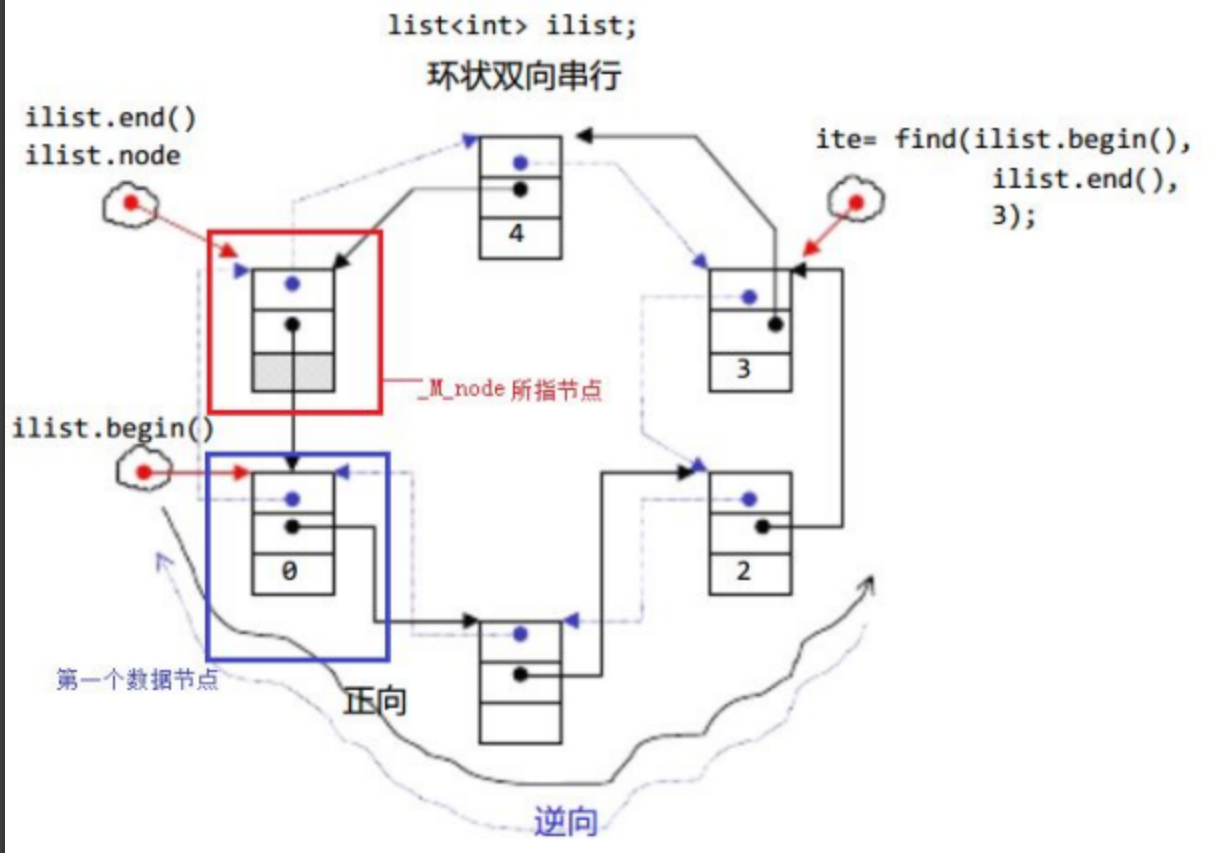目录
STL—容器—list
list的使用并不难,有了之前使用string和vector的基础后,学习起来并不难。因此这里不在详细的讲解如何使用,而是大致的将其基本接口都熟悉一下
1.list介绍
- list是可以在常数范围内在任意位置进行插入和删除的序列式容器,并且该容器可以前后双向迭代。其实就是双向循环链表
- list的底层是双向链表结构,双向链表中每个元素存储在互不相关的独立节点中,在节点中通过指针指向其前一个元素和后一个元素。
- list与forward_list非常相似:最主要的不同在于forward_list是单链表,只能朝前迭代,已让其更简单高效。
- 与其他的序列式容器相比(array,vector,deque),list通常在任意位置进行插入、移除元素的执行效率更好。
- 与其他序列式容器相比,list和forward_list最大的缺陷是不支持任意位置的随机访问,比如:要访问list的第6个元素,必须从已知的位置(比如头部或者尾部)迭代到该位置,在这段位置上迭代需要线性的时间开销;list还需要一些额外的空间,以保存每个节点的相关联信息(对于存储类型较小元素的大list来说这可能是一个重要的因素。

2.list的使用
ist中的接口比较多,此处类似,只需要掌握如何正确的使用,然后再去深入研究背后的原理,从而达到可扩展的能力。以下为list中一些常见的重要接口
2.1list的构造

list (size_type n, const value_type& val = value_type()),构造n个值val的元素的listlist(),构造空的listlist (const list& x),拷贝构造list (InputIterator first, InputIterator last),迭代器构造
四个构造函数的使用代码:
void test1()
{
// list (size_type n, const value_type& val = value_t)
list<int> l1(5, 1);
list<int>::iterator it1 = l1.begin();
while (it1 != l1.end())
{
cout << *it1 << " ";
++it1;
}
cout << endl;
//list (const list& x)
list<int> l2(l1);
list<int>::iterator it2 = l2.begin();
while (it2 != l2.end())
{
cout << *it2 << " ";
++it2;
}
cout << endl;
//list()
list<int> l3;
l3.push_back(2);
l3.push_back(3);
l3.push_back(4);
list<int>::iterator it3 = l3.begin();
while (it3 != l3.end())
{
cout << *it3 << " ";
it3++;
}
cout << endl;
// list(InputIterator first, InputIterator last)
list<int> l4(l3.begin(), l3.end());
list<int>::iterator it4 = l4.begin();
while (it4 != l4.end())
{
cout << *it4 << " ";
it4++;
}
cout << endl;
}
2.2 list 迭代器的使用
list是一个双向迭代器,因为其结构是双向链表,如果是list_forword就是单向迭代器。vector是随机迭代器——支持begin + n的操作,可以随机访问。
正向迭代器,反向迭代器,带const的正向迭代器,带const的反向迭代器
正向迭代器用begin()和end(),反向的用rbegin() 和 rend()

【注意】
-
begin与end为正向迭代器,对迭代器执行++操作,迭代器向后移动
-
rbegin(end)与rend(begin)为反向迭代器,对迭代器执行++操作,迭代器向前移动
使用代码如下:
// 带const迭代器的使用
void print_list(const list<int>& l)
{
list<int>::const_iterator cit = l.begin();
while (cit != l.end())
{
cout << *cit << " ";
cit++;
}
cout << endl;
}
// 带const的反向迭代器的使用
void print_reverse_list(const list<int>& l)
{
list<int>::const_reverse_iterator rit = l.rbegin();
while (rit != l.rend())
{
cout << *rit << " ";
++rit;
}
cout << endl;
}
// 迭代器的使用
void test2()
{
list<int> l;
l.push_back(1);
l.push_back(1);
l.push_back(1);
l.push_back(1);
l.push_front(0);
l.push_front(-1);
l.pop_back();
l.pop_back();
list<int>::iterator it = l.begin();
while (it != l.end())
{
cout << *it << " ";
it++;
}
cout << endl;
print_list(l);
list<int>::reverse_iterator rit = l.rbegin();
while (rit != l.rend())
{
cout << *rit << " ";
rit++;
}
cout << endl;
print_reverse_list(l);
}
要注意:
只要支持迭代器的容器就支持范围for循环、
// 范围for循环,只要支持迭代器的容器就支持范围for循环、
void test4()
{
list<string> ls;
ls.push_back("aaa");
ls.push_back("bbb");
ls.push_back("ccc");
for (auto e : ls)
{
cout << e << " ";
}
cout << endl;
}
2.3赋值运算符的使用
这个就和之前的赋值运算符一样用就行,比较简单。
// 赋值运算符
void test3()
{
list<int> l1;
l1.push_back(1);
l1.push_back(2);
list<int> l2;
l2 = l1;
print_list(l2);
}
2.4 list capacity()

在list容器中,不太存在容量这个接口,因为不会有提前开辟的空间等待使用,没什么意义,而是用多少开多少。
empty和size接口的使用
// empty 和 size接口的使用
void test1()
{
list<int> l;
l.push_back(1);
if (l.empty())
{
cout << "该list为空\n";
cout << l.size() << endl;
}
else
{
cout << "该list不为空\n";
cout << l.size() << endl;
}
}
2.5 list element access

front和back的使用:
// front 和 back的使用
void test2()
{
list<int> l;
l.push_back(1);
l.push_back(2);
l.push_back(3);
l.push_back(4);
cout << l.front() << endl; // 1
cout << l.back() << endl; // 4
}
2.6list modifiers(增删查改)
这里只展示了部分的接口

使用代码如下:
// 增删查改类接口使用
void test3()
{
list<int> l;
// push_back
l.push_back(3);
l.push_back(4);
print_list(l); // 3 4
// push_front
l.push_front(2);
l.push_front(1);
print_list(l); // 1 2 3 4
// pop_back / pop_front
l.pop_back();
l.pop_front();
print_list(l); // 2 3
// insert
l.insert(l.begin(), 0);
l.insert(l.end(), 4);
l.insert(++l.begin(), 1);
auto pos = ++l.begin();
l.insert(pos, 1);
print_list(l); // 0 1 1 2 3 4
// erase
l.erase(l.begin());
l.erase(--l.end());
pos = l.begin();
l.erase(pos);
print_list(l); // 1 2 3
// swap
list<int> l2;
l2.push_back(1);
l2.push_back(1);
l2.push_back(1);
l.swap(l2);
cout << "l: ";
print_list(l); // l: 1 1 1
cout << "l2:";
print_list(l2); // l2: 1 2 3
// clear
l2.clear(); // 虽然有效元素被清空了,但是并不意味着l2为空
if (l2.empty())
{
cout << "l2不为空\n";
print_list(l2);
}
else
{
cout << "l2为空\n";
}
}
// find
list<int>::iterator posn = find(l.begin(), l.end(), 3); // find没找到返回l.end()的位置
if (posn != l.end())
{
l.insert(posn, 30); // 在list下这里的posn不会失效,但是vector下就会失效了。
}
print_list(l);
在使用接口的时候,如果遇到不会的,可以查阅文档
3.list的迭代器失效问题
在讲述list的迭代器失效问题,我们先来看一个例子:
void print_list(const list<int>& l)
{
list<int>::const_iterator cit = l.begin();
while (cit != l.end())
{
cout << *cit << " ";
++cit;
}
cout << endl;
}
void print_vector(const vector<int>& v)
{
vector<int>::const_iterator cit = v.begin();
while (cit != v.end())
{
cout << *cit << " ";
++cit;
}
cout << endl;
}
void test1()
{
list<int> l;
l.push_back(1);
l.push_back(2);
l.push_back(3);
l.push_back(4);
list<int>::iterator pos1 = find(l.begin(), l.end(), 3);
if(pos1 != l.end())
{
l.insert(pos1, 30);
// insert完成后,pos迭代器不会失效。因为他是list结构,vector就会直接崩溃
l.erase(pos1);
}
print_list(l);
vector<int> v;
v.push_back(1);
v.push_back(2);
v.push_back(3);
v.push_back(4);
vector<int>::iterator pos2 = find(v.begin(), v.end(), 3);
if (pos2 != v.end())
{
v.insert(pos2, 30);
// insert之后的pos2迭代器失效了。
//v.erase(pos2); // vs里直接报错
}
print_vector(v);
}
在这段代码中,list中使用insert插入数据后的pos1不会在成为失效的迭代器,这是因为list是双向链表的结构,链表的数据是放在一个个结点中的,因此pos1指向的数据不会被移动,也不会改变。

而vector中就会让pos2成为失效的迭代器,**原因是:**1.不增容会导致pos2指向的数据出现错误。2.增容
了会直接导致pos2成为野指针。因为v的地址变动了。具体可以复习vector。STL—容器—vector-CSDN博客这篇博客中有讲述vector的两种迭代器失效的情况。

经过上面的例子分析,我们发现list特殊的双向链表结构导致vector中出现的这种迭代器失效的情况不会在list中出现。
但是list还是存在着迭代器失效的情况。
下面我们就来看看这个情况,在学习vector的时候说过,此处大家可将迭代器暂时理解成类似于指针,迭代器失效即迭代器所指向的节点的无效,即该节点被删除了。因为list的底层结构为带头结点的双向循环链表,因此在list中进行插入时是不会导致list的迭代器失效的,只有在删除时才会失效,并且失效的只是指向被删除节点的迭代器,其他迭代器不会受到影响。
来看一段代码:
// list的迭代器失效问题
void test2()
{
// 只有删除节点的时候会失效
int arr[] = { 1,2,3,4,5,6,7,8,9,10 };
list<int> l(arr, arr + sizeof(arr) / sizeof(arr[0]));
list<int>::iterator it = l.begin();
while (it != l.end())
{
l.erase(it);
// 此时的it已经是无效了。因为所指向的节点已经被删除了
++it;
}
print_list(l);
}
正确代码:
void test2()
{
// 只有删除节点的时候会失效
int arr[] = { 1,2,3,4,5,6,7,8,9,10 };
list<int> l(arr, arr + sizeof(arr) / sizeof(arr[0]));
list<int>::iterator it = l.begin();
while (it != l.end())
{
l.erase(it++); // 或者是it = l.erase(it);
}
print_list(l);
}
总结:
list在oj的使用频率没有vector出现的频率那么高,因此这边我们只是简单的使用list的基本接口就足够了,重点是在list的模拟实现上。






















 1万+
1万+

 被折叠的 条评论
为什么被折叠?
被折叠的 条评论
为什么被折叠?








